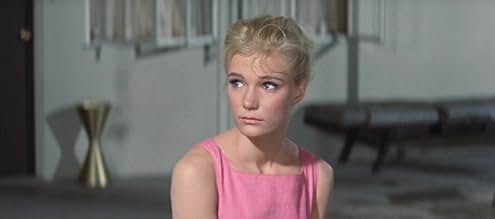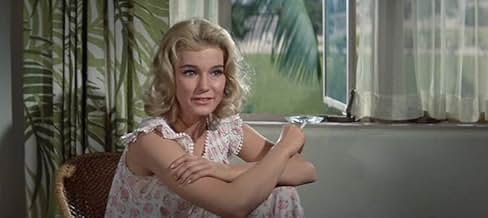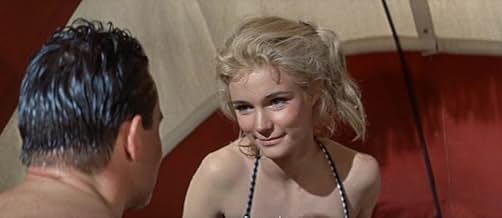CALIFICACIÓN DE IMDb
6.7/10
3.2 k
TU CALIFICACIÓN
Cuatro chicas universitarias muy diferentes conducen a Fort Lauderdale, Florida para las vacaciones de primavera y buscan varias aventuras y romance para ellas mismas.Cuatro chicas universitarias muy diferentes conducen a Fort Lauderdale, Florida para las vacaciones de primavera y buscan varias aventuras y romance para ellas mismas.Cuatro chicas universitarias muy diferentes conducen a Fort Lauderdale, Florida para las vacaciones de primavera y buscan varias aventuras y romance para ellas mismas.
- Premios
- 2 nominaciones en total
Carol Byron
- Sybil
- (sin créditos)
John Cliff
- Policeman at Hospital
- (sin créditos)
Oliver Cross
- Nightclub Patron
- (sin créditos)
Jack Deery
- Nightclub Patron
- (sin créditos)
Amy Douglass
- Dr. Raunch
- (sin créditos)
Dennis Durney
- Young Man
- (sin créditos)
- Dirección
- Guionistas
- Todo el elenco y el equipo
- Producción, taquilla y más en IMDbPro
Argumento
¿Sabías que…?
- TriviaDolores Hart left Hollywood a few years after this movie was released and became a Benedictine nun; she has been a Mother Superior for many years. As a member in good standing of the Academy of Motion Picture Arts and Sciences, she is the only nun who votes for the Oscars.
- ErroresWhen the kids are first introduced to Basil's jazz band, hundreds of kids rush to the bar, with the main characters in the rear. Yet, the main characters somehow manage to find one of the few tables in the bar.
- Citas
Police Captain: Wait a minute! Haven't I seen you in here before?
Lola Fandango: Just once, and it was purely by accident. The night my strap broke?
[she shows her very revealing top]
- Créditos curiosos"and introducing Connie Francis"
- ConexionesFeatured in Where the Boys Were: A Retrospective (2004)
- Bandas sonorasWhere the Boys Are
Words by Howard Greenfield
Music by Neil Sedaka
Performed by Connie Francis (uncredited)
Courtesy of Nevins - Kirshner
Opinión destacada
Forty-five years have elapsed since its original release, but it is amazing how this 1960 film introduced a particular genre that continues to be produced today granted in a far more explicit manner - the spring-break, beach-party movie where attractive teens go through a sun-drenched mating ritual and somehow love triumphs over carnal knowledge. Back then, the concept didn't seem quite as jaded as it does now, and consequently there is an entertaining naiveté about the timeworn story of four co-eds from a snowy Midwestern college who journey to Ft. Lauderdale for spring break to meet boys.
The plot is based on the then-accepted notion that girls in college are only marking time waiting for husbands to come along, but the journey to that goal depends on the girl. The four in question are Merritt, a smart blonde who is not living up to her academic potential as she questions the moral code around premarital sex; Melanie, so deeply insecure she mistakes sex for love with a less-than-honorable Ivy Leaguer; Tuggle, a tall brunette who zeroes in on an even taller, eccentric hitchhiker; and Angie, the supposedly plain one who gets used to being ignored by men.
Directed in a perfunctory fashion by Henry Levin, this is not the type of movie where you are terribly impressed with the performances, but I have to say the acting is certainly miles above subsequent beach-party movies. Elvis' former leading lady Dolores Hart plays Merritt credibly even as she is being seduced by a youthful George Hamilton wanly playing Ryder, a well-to-do Ivy Leaguer with a conveniently located yacht. As the most troubled of the girls, Yvette Mimieux (always loved her name) accurately captures the constantly forlorn, little-girl-lost state of Melanie, a teen-aged Blanche du Bois in the making.
So pert and charming as Angie, Connie Francis actually seems miscast as a plain-Jane, especially when she sings "Turn on the Sunshine" with a stage polish completely out of character. The standout is Paula Prentiss who portrays Tuggle with her unique personality in full bloom and partnered the first of several times with Jim Hutton as the comically obnoxious TV. She is an under-appreciated comedienne with a loopy charm and vibrantly twangy voice all her own - it's a shame her career never really took off the way it deserved to.
I think the film does make a valid, sometimes even perceptive attempt to address the confusion that Eisenhower-era girls had over sex and love. Girls were expected to function under a double-standard where the only way to attract boys was to have something to offer but at the price of their reputations. This point is hammered home when the tone shifts in the last portion to melodrama. At the same time, the film is filled with predictable comic scenes, including a contrived mêlée in an underwater tank with the zaftig and nasal Barbara Nichols as Esther Williams-wannabe Lola Fandango.
Prentiss offers her services and remembrances to the alternate audio commentary track on the DVD, which also comes with a looking-back featurette which includes interviews with Prentiss and Francis. Who knew this film would launch a hundred imitations? The minute you hear Francis sing the title tune, it is hard for a baby boomer not to get nostalgic. If you have an interest in understanding the mid-century moral code enforced upon the youth of America, especially girls, I can think of worse films to see.
The plot is based on the then-accepted notion that girls in college are only marking time waiting for husbands to come along, but the journey to that goal depends on the girl. The four in question are Merritt, a smart blonde who is not living up to her academic potential as she questions the moral code around premarital sex; Melanie, so deeply insecure she mistakes sex for love with a less-than-honorable Ivy Leaguer; Tuggle, a tall brunette who zeroes in on an even taller, eccentric hitchhiker; and Angie, the supposedly plain one who gets used to being ignored by men.
Directed in a perfunctory fashion by Henry Levin, this is not the type of movie where you are terribly impressed with the performances, but I have to say the acting is certainly miles above subsequent beach-party movies. Elvis' former leading lady Dolores Hart plays Merritt credibly even as she is being seduced by a youthful George Hamilton wanly playing Ryder, a well-to-do Ivy Leaguer with a conveniently located yacht. As the most troubled of the girls, Yvette Mimieux (always loved her name) accurately captures the constantly forlorn, little-girl-lost state of Melanie, a teen-aged Blanche du Bois in the making.
So pert and charming as Angie, Connie Francis actually seems miscast as a plain-Jane, especially when she sings "Turn on the Sunshine" with a stage polish completely out of character. The standout is Paula Prentiss who portrays Tuggle with her unique personality in full bloom and partnered the first of several times with Jim Hutton as the comically obnoxious TV. She is an under-appreciated comedienne with a loopy charm and vibrantly twangy voice all her own - it's a shame her career never really took off the way it deserved to.
I think the film does make a valid, sometimes even perceptive attempt to address the confusion that Eisenhower-era girls had over sex and love. Girls were expected to function under a double-standard where the only way to attract boys was to have something to offer but at the price of their reputations. This point is hammered home when the tone shifts in the last portion to melodrama. At the same time, the film is filled with predictable comic scenes, including a contrived mêlée in an underwater tank with the zaftig and nasal Barbara Nichols as Esther Williams-wannabe Lola Fandango.
Prentiss offers her services and remembrances to the alternate audio commentary track on the DVD, which also comes with a looking-back featurette which includes interviews with Prentiss and Francis. Who knew this film would launch a hundred imitations? The minute you hear Francis sing the title tune, it is hard for a baby boomer not to get nostalgic. If you have an interest in understanding the mid-century moral code enforced upon the youth of America, especially girls, I can think of worse films to see.
- EUyeshima
- 7 feb 2006
- Enlace permanente
Selecciones populares
Inicia sesión para calificar y agrega a la lista de videos para obtener recomendaciones personalizadas
Detalles
- Fecha de lanzamiento
- País de origen
- Sitios oficiales
- Idioma
- También se conoce como
- Where the Boys Are
- Locaciones de filmación
- Fort Lauderdale, Florida, Estados Unidos(some exteriors)
- Productora
- Ver más créditos de la compañía en IMDbPro
- Tiempo de ejecución1 hora 39 minutos
- Relación de aspecto
- 2.35 : 1
Contribuir a esta página
Sugiere una edición o agrega el contenido que falta

Principales brechas de datos
By what name was Se necesitan dos para amar (1960) officially released in India in English?
Responda





























